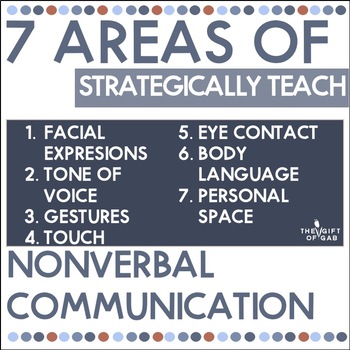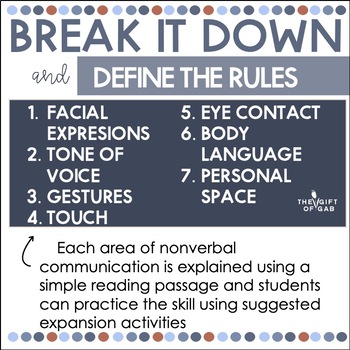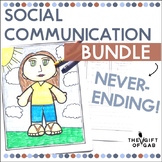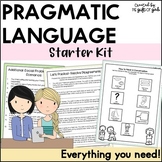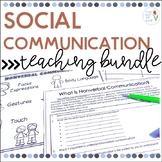Nonverbal Communication Activities | Social Emotional Learning Activities
- PDF
- Easel Activity
What educators are saying
Also included in
- Have you ever struggled to create pragmatic language activities for a speech therapy, social skills, or Autism group? Many of us have developed our social communication abilities without much thought, which can make breaking down these complicated skills into easy to understand steps, challenging. WPrice $83.41Original Price $119.15Save $35.74
- Many of us have developed our pragmatic language skills without much thought, which can make breaking down these complicated skills into easy-to-understand steps quite challenging. The pragmatic activities in this bundle use a methodical approach to teach and evaluate common areas of social languagePrice $19.60Original Price $27.60Save $8.00
- Have you ever wondered where to begin teaching a pragmatic language skill? Or once you started, did you wonder how to teach that skill strategically? With this social communication bundle you won't feel like that any more! This bundle of social skills activities strategically guides you through thePrice $30.98Original Price $44.00Save $13.02
Description
Can you name 7 examples of nonverbal communication? Nonverbal communication can be tricky to teach. Most of us have learned these social-emotional skills effortlessly, which makes breaking them down into easy-to-understand lessons quite tricky.
The activities in this resource discuss the seven main areas of nonverbal communication (facial expressions, body language, gestures, touch, personal space, eye contact, and tone of voice). Each area of nonverbal communication is introduced with a reading passage and contains an expansion activity so students can practice the skills.
Are you still wondering how to teach nonverbal communication? I've got you! These activities help you teach these vague social skills using a concrete, methodic approach. This will improve your student's understanding of nonverbal communication and why nonverbal communication is important!
Save 30% on this resource by purchasing it as part of the NEVER ENDING Social Communication BUNDLE!
This resource contains the following activities:
- Nonverbal Communication Poster: A poster displaying visual representations of the seven main areas of nonverbal communication.
- Introduction Reading Passage: A reading passage and comprehension questions introducing nonverbal communication.
- Introduction Activity: An activity suggestion for introducing the types of nonverbal communication.
- Facial Expressions Introduction: The six main facial expressions are explicitly explained so that students can understand how to decipher facial expressions.
- Facial Expressions Expansion Activity: An activity suggestion for analyzing facial expressions.
- Facial Expressions and Other Emotions: A vocabulary activity to help students understand the root emotion and facial expression behind complex emotions (answer key included)
- Gestures Reading Passage: A reading passage and comprehension questions introducing and explaining different kinds of gestures.
- Gestures Expansion Activity #1: Students draw familiar gestures and define them.
- Gestures Expansion Activity #2: Students become familiar with and define less common gestures.
- Touch Reading Passage: A reading passage and comprehension questions introducing and explaining different kinds of touch.
- Touch Expansion Activity: Students discuss the different kinds of touch and make a chart explaining when they might experience or use different kinds of touch.
- Proxemics (Personal Space) Reading Passage: A reading passage and comprehension questions introducing and explaining different kinds of personal space.
- Proxemics (Personal Space) Expansion Activity: An activity suggestion where students discuss the different levels of personal space and when each one is appropriate.
- Whole Body Language Reading Passage: A reading passage and comprehension questions introducing and explaining whole body language.
- Whole Body Language Expansion Activity: An activity suggestion where students analyze whole body language and what it is communicating.
- Vocalics (Tone of Voice) Reading Passage: A reading passage and comprehension questions introducing and explaining tone of voice.
- Vocalics (Tone of Voice) Expansion Activity: Students explore how situations and emotion change tone of voice. Students are given a scenario and emotion and practice saying the same word with different tones.
- Eye Contact Reading Passage and Discussion Questions: A reading passage and comprehension questions introducing and explaining eye contact. Discussion questions are provided to help students explore and identify their understanding and use of eye contact during nonverbal communication.
- Physical Appearance Reading Passage: A reading passage and comprehension questions introducing and explaining physical appearance. Discussion questions are provided to help students explore and identify their understanding and use of physical appearance as it relates to nonverbal communication.
- Starting a Conversation Reading Passage: A reading passage and comprehension questions introducing and explaining how nonverbal communication can help you know when to start a conversation. Different strategies for using nonverbal communication to start a conversation are discussed.
- Starting a Conversation Expansion Activity: An activity suggestion where students practice using nonverbal conversation starter strategies in pretend situations. Students identify which strategy is best for different situations. (Answer key included)
Thank you so much,
Jessica, The Gift of Gab
I would love it if you would take a second and follow my store! All new resources are 50% off for the first 24 hours, so you can save money by following me!
You might also be interested in these social skills resources from my store:


